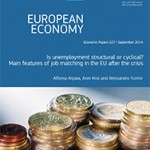Is unemployment structural or cyclical? Main features of job matching in the EU after the crisis
 This paper sheds light on developments in labour market matching in the EU after the crisis.
This paper sheds light on developments in labour market matching in the EU after the crisis.
First, it analyses the main features of the Beveridge curve and frictional unemployment in EU countries, with a view to isolate temporary changes in the vacancy-unemployment relationship from structural shifts affecting the efficiency of labour market matching. Second, it explores the main drivers of job matching efficiency, notably with a view to gauge whether mismatches became more serious across skills, economic sectors, or geographical locations and to explore the role of the policy setting. It emerges that labour market matching deteriorated after the crisis, but with a great deal of heterogeneity across EU countries. Divergence across countries increased. Matching deteriorated most in countries most affected by current account reversals and the debt crisis. The lengthening of unemployment spells appears to be a significant driver of matching efficiency especially after the crisis, while skill and sectoral mismatches also played a role. Active labour market policies are associated with a higher matching efficiency and some support is found to the hypothesis that more generous unemployment benefits reduce matching efficiency.
Download the full paper: Is unemployment structural or cyclical? Main features of job matching in the EU after the crisis
Download the Summary for non-specialists










